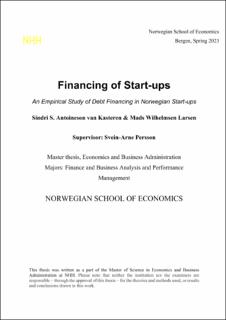Financing of Start-ups : An Empirical Study of Debt Financing in Norwegian Start-ups
Master thesis
Permanent lenke
https://hdl.handle.net/11250/3098023Utgivelsesdato
2023Metadata
Vis full innførselSamlinger
- Master Thesis [4372]
Sammendrag
The main goal of this thesis is to identify factors which determine the debt levels of Norwegian
start-ups and how debt financing develops as firms mature. This is achieved by analysing a
dataset consisting of 100.381 observations on 18.923 individual start-up firms from eight
different industries.
Our findings show that there are significant differences in debt ratios between industries,
however, the development of debt ratios follows the same trend across industries. As start-ups
mature, they tend to tend to take on more interest-bearing debt. Nonetheless, prefer utilizing
retained earnings which results in declining debt ratios over time.
Results from our regression analysis indicate that both the asset size- and structure
significantly impact the accessibility of long-term debt for Norwegian start-ups. Furthermore,
profitable firms tend to favour internal financing given by the negative relationship between
Return on Average Assets (ROAA) and both the long- and short-term debt ratio. However, our
results also reveal that start-ups prefer to finance growth with external debt. This is evidenced
by both Growth Sales and Growth Opportunity being positively correlated with long-term
interest-bearing debt ratio (LTDR), whereas short-term interest-bearing debt ratio (STDR) is
positively correlated with Growth Sales but negatively affected by increased Growth
Opportunity. Indicating that start-ups prefer using long-term interest-bearing debt to finance
future growth opportunities.
When investigating whether the initial capital structure has any impact on the development of
debt financing, our findings support the Financial Growth Cycle theory but contradict earlier
empiricism. Based on our findings, the initial capital structure appears inconsequential as all
debt ratios revert towards an overall mean over time. The difference being highly initial debtfinanced
start-ups appear more mature and less informational opaque than their counterparts
at commencement.
